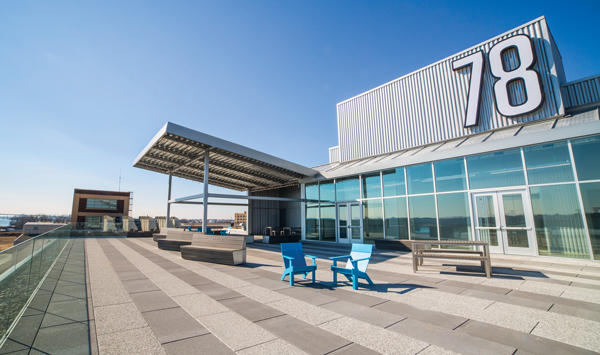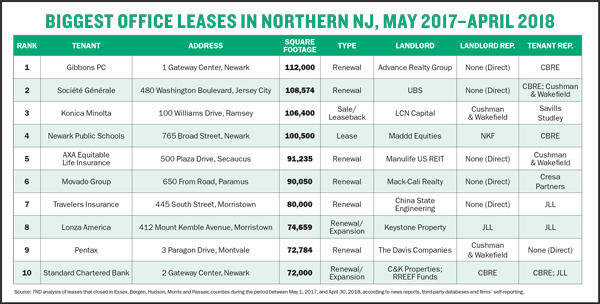Trending
 “Multifamily is in the crosshairs”: Execs talk distress, opportunities at Milken conference
“Multifamily is in the crosshairs”: Execs talk distress, opportunities at Milken conference Pinnacle Bank buys back Fort Worth office tower for $12 per sf
Pinnacle Bank buys back Fort Worth office tower for $12 per sf  "Financially devastating": Receiver takes over embattled Pembroke Pines condo complex
"Financially devastating": Receiver takes over embattled Pembroke Pines condo complex Blackstone sells huge industrial portfolio in NYC, New Jersey
Blackstone sells huge industrial portfolio in NYC, New JerseyOffice deals make for heavy lifting
Downsizing companies and slow-going negotiations made for smaller deals on TRD’s ranking of biggest leases, but some brokers say they’re getting higher rents

Last year’s sluggish New Jersey office leasing market continued into 2018, as vacancies rose and absorption declined in the first quarter. Indeed, new leasing deals of any substantive size were hard to come by. An analysis by The Real Deal showed that in the 12 months between May 2017 and April 2018, almost all of the biggest leases — eight of the top 10 — were renewals.
Not only was there a dearth of deals for more than 100,000 square feet, but there were only six new deals for more than 20,000 square feet signed during the first quarter, according to Cushman & Wakefield.
TRD’s top 10 transactions for the 12 months ending in April ranged from a scant 72,000 square feet to a middling 112,000. By contrast, in 2017, the smallest of the top 10 deals came in at 126,000 square feet, and the largest was nearly 432,000. Half were brand-new leases.
Struggling market
Part of the reason for the lack of large office leases is that many companies are downsizing, brokers said.
“You’re not seeing as much velocity or deals in the market currently…or over the past 12 to 18 months,” said Jamie Drummond, senior managing director of Newmark Knight Frank in Rutherford. “There’s been a lot of consolidation, tenants going from 150,000 square feet and consolidating two or three offices into 60,000 square feet.”
Protracted negotiations are also taking a toll on volume, especially when it comes to larger blocks of space, said Jason Price, director of tri-state suburban research for Cushman. “Larger deals are taking longer to get done,” he said. “With incentives and debates [about] locations, decisions dragged on.”
The leasing volume underscores just how lukewarm the market is. Total square feet leased was down nearly 48 percent in the first quarter: 722,099 square feet of space compared to 1,380,017 square feet in 2017, according to Cushman. Overall absorption was negative — as it was in the first quarter of 2017 — but the first few months of 2018 showed a starker scene, with 628,339 square feet of negative absorption compared to 262,179 in the year prior.
Overall vacancies edged up too, increasing to 19.7 percent from 19 percent. However, at 18.5 percent, the vacancy rates in Class B buildings painted a slightly brighter picture, with some brisk leasing by small businesses that mostly can’t afford a $40 or $45 per square foot price tag, the rent for waterfront Class A space, according to Price. Average asking rents ticked up year-over -year, rising 7.2 percent and ending the first quarter at $30.13.
 Brokers say it’s still a tenants’ market. “The rentals are holding, but there’s a lot of free rent being offered,” said Dennis Gralla, managing principal of Cresa New Jersey. Tenants are seeing an average of one month free rent per lease term year, he said, “and, if the lease goes to 10 years, up to a year free.”
Brokers say it’s still a tenants’ market. “The rentals are holding, but there’s a lot of free rent being offered,” said Dennis Gralla, managing principal of Cresa New Jersey. Tenants are seeing an average of one month free rent per lease term year, he said, “and, if the lease goes to 10 years, up to a year free.”
Tenant improvement allowances are also generous at $40 to $50 per square foot, added Gralla. “That’s very high for New Jersey,” he said, adding that it would have been more like $30 per square foot a few years ago.
The biggest deals
Gralla brokered one of the 10 top leases inked in the past year, a renewal of watchmaker Movado’s 90,050 square feet at 650 From Road in Paramus, the company’s headquarters since 2001. Before the renewal, Gralla conducted a search of a 15-mile radius for a possible move, but in the end, he said, “it’s a location that has always worked for them.”
The largest deal of the top 10 was a renewal by national law firm Gibbons PC of its 112,000-square-foot headquarters at 1 Gateway Center in Newark; the smallest was Standard Chartered Bank’s renewed lease on its 72,000-square-foot offices at nearby 2 Gateway Center.
Standard Chartered moved to that location 10 years ago, said CBRE’s Dudley Ryan, who characterized the building as ideal for mission critical operations given its efficient high-volume telecommunications capabilities. “It doesn’t matter what industry you’re in,” said Ryan. “Even lawyers are becoming more conscious of redundancy and efficiency.”
Other sizable deals included Société Générale’s renewal of just over 108,500 square feet at 480 Washington Boulevard in Jersey City and a sale/leaseback by Konica Minolta of 106,400 square feet at 100 Williams Drive in Ramsey.
In another transaction, Lonza America — a supplier to bioscience and healthcare companies — is planning a move from Allendale in Bergen County to Kemble Plaza II in Morris Township.
There it will join its recently acquired subsidiary Capsugel and renew and expand that company’s lease, said Dennis McConnell, the JLL executive vice president who brokered the deal. At 74,659 square feet, the lease took the eighth spot on the ranking.
Less space, higher rent
Some submarkets did better than others, particularly urban markets such as Hudson and Essex counties, where the vacancy rates in the first quarter were 17.2 percent and 17.9 percent, respectively. Overall average asking rents for Class A properties in Hudson County and on the waterfront were in the mid-$40s, up from the low $40s a year ago, according to Cushman.
Cushman also reported that the waterfront, the Meadowlands and Morristown all recorded increases in new leasing. In its first-quarter earnings call, New Jersey real estate giant Mack-Cali told analysts that it was seeing increased inquiries, tours and proposals in its waterfront portfolio.
Also on an upswing, said brokers, are the 20- and 30-year-old suburban buildings where owners have made substantial upgrades to attract tenants that, in turn, are eager to attract a new generation of workers. The newly amenitized buildings, replete with fitness centers, outdoor athletic facilities and concierge services, are seeing more action, said New Jersey real estate veterans. (See our full coverage on page 38.)
“Even though, by and large, we are not having net gains in occupied space, we are finding that the deals that are getting done are getting done in buildings that are renovated and are attracting higher rents,” said Cushman vice chairman Robert Rudin. “Just recently, we are seeing landlords start to command premium rents.”
Similarly, à la the Brooklyn Navy Yard and Industry City, development firm Hugo Neu is overhauling a WWI-era shipyard in South Kearny to create Kearny Point, a 130-acre, 2 million-square-foot development with modern and flexible office space, all of it well amenitized.
One building, which houses startups and small businesses, is 98percent occupied, according to reports.
Retiring office space
The makeovers are also going the other way. In an effort to neutralize the hangover of outdated commodity office buildings, some owners are starting to repurpose old office properties for industrial, warehouse or residential use.
“For properties that haven’t leased in a while [and] have become less appealing, a lot are coming offline and are being rebuilt for other uses,” said Michael Seeve of Mountain Development Corp. “We’re definitely seeing more and more office space that doesn’t work being reinvented.”
Mack-Cali, for one, overhauled a former office building site at 250 Johnson Road in Morris Plains, turning it into a 197-unit multi-family residential building. It’s part of the REIT’s strategy to shrink suburban office assets and focus on properties in denser, millennial-friendly transit hubs, as well as on multifamily luxury properties in urban centers.
Mack-Cali, which moved its headquarters from Edison to Jersey City in 2016, said it has sold all its Maryland, Washington, D.C. and New York City office properties and since 2015 has disposed of dozens of office buildings in New Jersey totaling around 6 million rentable square feet, among them all its office assets in Bergen County, a market that CEO Michael DeMarco called “tough.”
“I didn’t want to own it long-term,” said DeMarco. “I didn’t think it was a good bet.”
At the same time, the company has sold — and bought — office properties in Parsippany and has acquired office assets in other downtown and urban northern Jersey markets, including Hoboken, Edison, Short Hills, Madison and Red Bank.
“Growth is the business I’m in,” DeMarco said. “You look at the quality of a building and ask ‘is this a building you want to own 10 years from now?’”
Looking down the line
Despite the first quarter’s slow market, some said they’re starting to see more action and that the market for quality buildings is getting tighter. Many are predicting more activity as the year progresses.
“I’m optimistic as the supply-and-demand equation rationalizes itself, as buildings are taken out of the supply side, and as the economy continues to perform well,” said Brian Decillis, a managing director at Cushman.
One big bright spot for the market: In December, candy maker Mars Wrigley Confectionery — bolstered by a $31 million tax incentive — announced it was moving 113 people from Chicago and 330 people from Hackettstown to Newark. Its new U.S. headquarters will be at the Ironside, a commercial and retail center that’s under construction in downtown Newark and has brokers betting that office leasing is on the cusp of an upturn. (See more about the Newark office market on page 16.)
“Anytime you’ve got a number of jobs moving into New Jersey, it’s a good sign for our state,” said Tim Greiner, JLL agency lead for New Jersey, adding that he’s currently tracking 12 local deals over 100,000 square feet.

